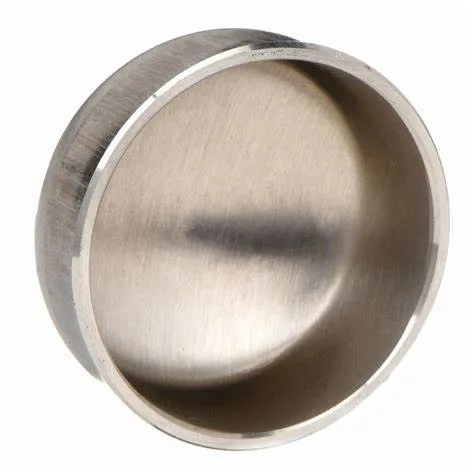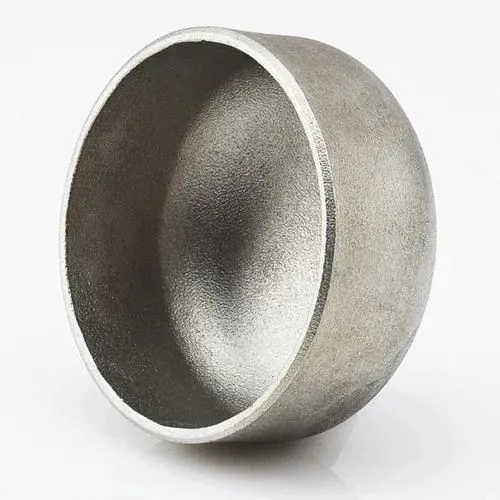JIS B2311, boru sistemlerinde kullanılan kapaklar da dahil olmak üzere alın kaynaklı boru bağlantı parçalarını kapsayan bir Japon Endüstri Standardıdır. Alın kaynak kapakları, sızıntıyı veya kirlenmeyi önlemek için bir sızdırmazlık sağlayarak borunun ucunu kapatma amacına hizmet eder. JIS B2311 alın kaynak kapaklarına bir giriş:
- 1. JIS B2311 Standard:
- - JIS B2311 standardı, boru sistemlerindeki kapaklar da dahil olmak üzere alın kaynak bağlantı parçalarının tasarımı, boyutları, malzemeleri, üretimi ve testine ilişkin gereksinimleri belirtir.
- - Standart, JIS standartlarına uygun olarak üretilen kapakların kalite standartlarını karşılamasını ve diğer boru bileşenleriyle uyumlu olmasını sağlar.
- 2. Alın Kaynak Başlığı:
- - JIS B2311'e göre alın kaynak başlığı, borunun ucunu güvenli bir şekilde kapatmak ve kapatmak için tasarlanmış, boru sisteminin bütünlüğünü koruyan ve koruma sağlayan bir bağlantı elemanıdır.
- - Kapaklar, boru ucunun kalıcı veya geçici olarak kapatılmasının gerektiği durumlarda sızıntıyı, kirlenmeyi önlemek veya sisteme son kat sağlamak için kullanılır.
- 3. Malzeme ve İnşaat:
- - JIS B2311 spesifikasyonlarına uygun alın kaynak başlıkları, farklı uygulama gereksinimlerini karşılamak için karbon çeliği, paslanmaz çelik ve alaşımlı çelik gibi çeşitli malzemelerde mevcuttur.
- - Bu kapaklar, borunun ucuna kaynak yapıldığında güçlü ve sızdırmaz bir bağlantı sağlamak için standart yapım yöntemleri kullanılarak üretilmiştir.
- 4. Uygulama ve Faydaları:
- - Alın kaynaklı kapaklar, petrol ve gaz, kimyasal prosesler, su arıtma tesisleri ve daha fazlası dahil olmak üzere boru uçlarının güvenli bir şekilde kapatılması gereken çeşitli endüstrilerde uygulama alanı bulur.
- - Kapaklar boru uçlarını çevresel unsurlardan korur, kirlenmeyi önler ve boru sisteminin temizliğinin ve bütünlüğünün korunmasına yardımcı olur.
- 5. Kurulum ve Kaynak:
- - Alın kaynak kapakları takılırken sıkı ve sızdırmaz bir sızdırmazlık sağlamak için doğru hizalama, boru ucunun hazırlanması ve kaynak teknikleri dahil olmak üzere uygun kurulum uygulamaları çok önemlidir.
- - Kaynak, borulara kapak takmak için yaygın olarak kullanılan bir yöntemdir ve sistem içindeki basınca, sıcaklık değişimlerine ve sıvı akışına dayanabilecek güvenli ve kalıcı bir kapatma sağlar.
- Özetle, JIS B2311 alın kaynak kapakları, boruların ucunu güvenli bir şekilde kapatmak ve korumak için boru sistemlerinde kullanılan önemli bileşenlerdir. Bu kapaklar, boru kapatma ve korumanın gerekli olduğu endüstriyel uygulamalarda kalite, güvenilirlik ve uyumluluk sağlamak için standart gereksinimlere uygundur.
What Is a Butt Welding Cap and How Is It Used in Industrial Piping?
In industrial piping systems, end-of-line sealing and branch closures require robust solutions. A butt welding cap serves as a critical component for terminating pipes securely. By providing a seamless, welded closure, this fitting maintains system integrity, prevents leaks, and supports compliance with industry standards.
What Is a Butt Welding Cap?
A butt welding cap—also called a pipe end cap or buttweld end cap—is a round fitting designed to close off the end of a pipe. It’s manufactured to match the pipe’s outer diameter and schedule, with either a hemispherical or flat face. To install, both the pipe end and cap are beveled to form a V‑groove, enabling full‑penetration, fusion welds. Common materials include carbon steel, stainless steel, nickel alloys, and other engineered grades, chosen to satisfy pressure, temperature, and corrosion‑resistance requirements.
How Is Butt Welding Cap Used in Industrial Piping?
Butt welding caps find application across oil & gas, petrochemical, power generation, water treatment, and general process industries for both permanent and temporary closures. During hydrostatic testing, technicians install caps to seal off sections of piping while monitoring for leaks. In new construction or retrofit projects, caps terminate branch lines, future tie‑in spools, or dead‑end mains until system expansion. Welders prepare each joint by cleaning and beveling surfaces, aligning the cap precisely, and executing a root pass followed by filler passes per the qualified Welding Procedure Specification (WPS). Post‑weld heat treatment and non‑destructive examination (NDE)—such as radiography or ultrasonic testing—verify weld integrity and compliance with ASME B16.9 and related standards. Additionally, temporary caps enable safe isolation during maintenance, allowing for segment testing and dewatering under regulatory protocols.
Benefits and Best Practices
Butt welding caps offer a smooth‑bore transition that minimizes flow disruption and stress concentration. Their full‑penetration welds deliver exceptional structural strength and leak resistance. To optimize performance, engineers should:
Select caps with matching material grades and wall thicknesses
Adhere to proper bevel angles and joint fit‑up tolerances
Follow qualified WPS protocols rigorously
Consider cladding or protective coatings in corrosive environments to extend service life
Regular inspection and thorough documentation ensure long‑term reliability and safe operation under demanding conditions.
Butt welding caps are indispensable components for achieving durable, leak‑proof pipe terminations in a wide range of industrial applications.
Butt Welding Cap FAQs
What is a butt welding cap?
|
What materials are commonly used?
|
What standards govern butt welding caps?
|
How are butt welding caps installed?
|
Where are butt welding caps typically used?
|
What are the advantages of threaded caps?
|
















